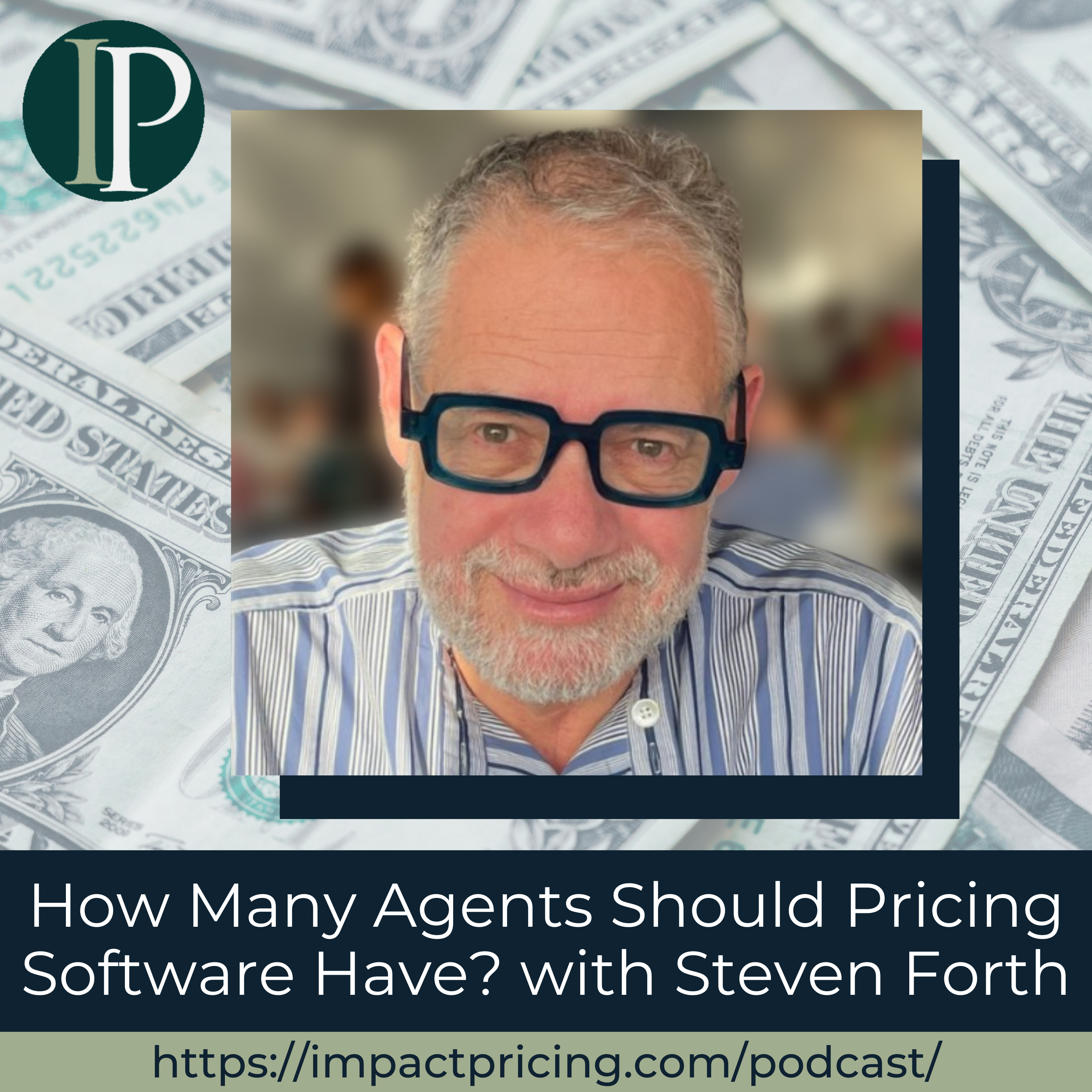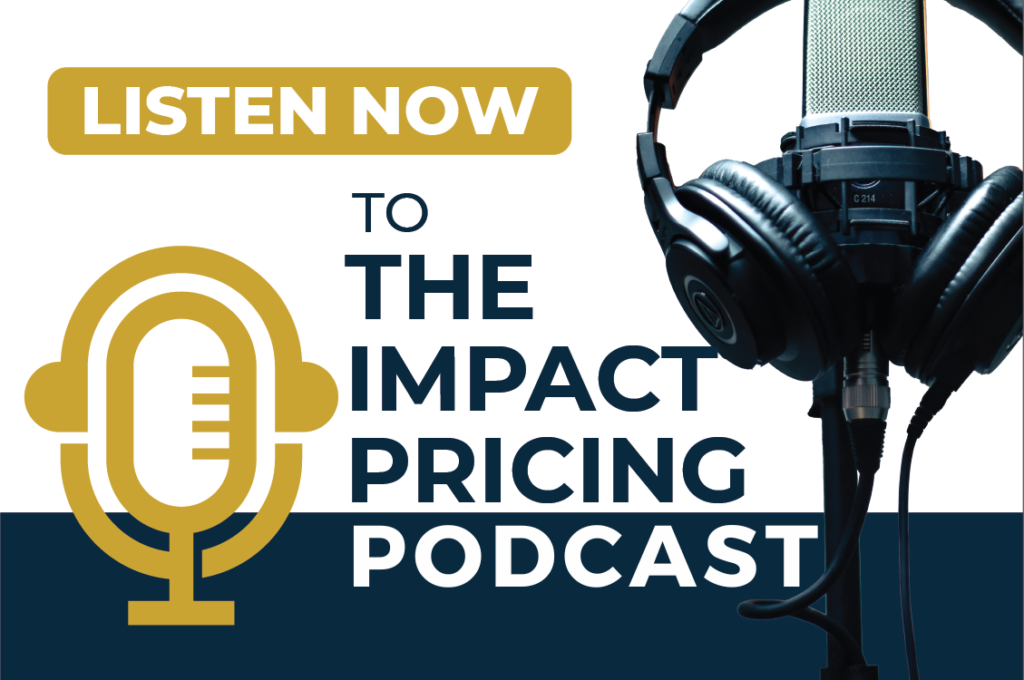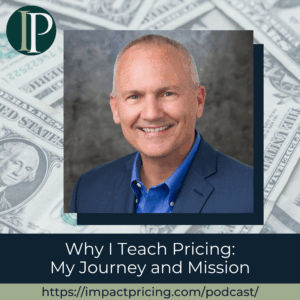
In this episode, Steven discusses his recent research comparing agent strategies across four major pricing software companies, explores the fundamental question of how many agents is optimal, and reveals how AI is transforming both the buying and selling process in ways most companies aren’t prepared for.
Podcast: Play in new window | Download
Why you have to check out today’s podcast:
- Learn how the four major pricing software companies (Pros, Vendavo, Zilliant, PriceFX) approach agent development differently.
- Discover the key difference between role-based and task-based agent design strategies.
- Understand how AI will fundamentally change B2B buying processes and what that means for pricing.
“Start using AI to get a deeper understanding of how your customers are buying. Because if you don’t understand how your customers are buying and buying using AI, you’re not going to be able to price properly.”
– Steven Forth
Topics Covered:
02:07 – ValueIQ introduction: Steven’s new agent platform for pricing and value advisory work.
06:34 – Defining agents: The difference between true agentic AI and wrapped LLM functionality.
10:49 – Sales agent complexity: Breaking down the many tasks salespeople perform and agent granularity.
12:35 – Pricing agents vs. features: How to decide between individual pricing and bundling strategies.
15:55 – The future of pricing models: Why “good, better, best” packaging may disappear in 2-3 years.
21:05 – AI’s role in B2B buying: How AI intermediaries will transform RFP processes and vendor selection.
25:06 – Understanding AI-powered customers: Why companies must learn how their buyers use AI in purchasing decisions.
Key Takeaways:
“When I saw that PriceFX announced that it had more than 125 agents… I thought, huh, that’s kind of a jaw-dropping number. I don’t think I could generate 125 agents for pricing software.” – Steven Forth
“The role of AI in the buying process is more important than the role of AI in the sales process.” – Steven Forth
“You’re going to be creating more content, not less. But that content is primarily going to be consumed by AIs.” – Steven Forth
“I think that many of the common packaging assumptions such as good, better, best are going to dissolve away over the next two or three years.” – Steven Forth
Resources and People Mentioned:
- Michael Mansard’s 14-factor model: https://www.linkedin.com/in/michaelmansard/
Connect with Steven Forth:
- LinkedIn: https://www.linkedin.com/in/stevenforth/
- Email: [email protected]
Connect with Mark Stiving:
- LinkedIn: https://www.linkedin.com/in/stiving/
- Email: [email protected]
Full Interview Transcript
(Note: This transcript was created with an AI transcription service. Please forgive any transcription or grammatical errors. We probably sounded better in real life.)
Steven Forth
Start using AI to get a deeper understanding of how your customers are buying. Because if you don’t understand how your customers are buying and buying using AI, you’re not going to be able to price properly.
[Intro / Ad]
Mark Stiving
Welcome to Impact Pricing, the podcast where we discuss pricing, value, and the agentic relationship between them. I’m Mark Stiving, and I run bootcamps to help companies get paid more. Our guest today is once again, Mr. Steven Forth.
Here are, well, two things you want to know about Steven. First, he’s the founder and CEO of Ibbaka, and he is by far our most frequent guest. I might have to start calling him a co-host. Welcome, Steven.
Steven Forth
Thank you, Mark. In fact, I think I did actually once co-host a podcast where I interviewed you about context-driven pricing.
Mark Stiving
You absolutely did. That was fun. It was interesting. I’ll put it that way.
Steven Forth
We should do it again.
Mark Stiving
We should. So first off, I don’t know if the listeners know this. I always ask my guests to pick the word when I say, pricing, value, and the relationship between them. And Steven complained to me and said, look, it’s hard to do that after a while. It is.
Which is why I started asking my guests to do it. But today was awesome, agentic. And if you happen to be watching this on YouTube, Steven had this huge smile on his face when I said that word. So are you just super proud that you came up with that word for today?
Steven Forth
I think it sounds a little bit silly. And if you asked me to explain the agentic relation between pricing and value, I would probably flub over a few times before I could sort it out. But I’m willing to take a try actually, because I think it’s relevant to the theme we want to talk about today. But why don’t we start with the theme?
Mark Stiving
Okay. Let’s start with the theme. Well, by the way, isn’t that the same as your new, is it a new company or new product you’re coming out with? ValueIQ.
Steven Forth
ValueIQ is the branding for a set of agents that we’ve been developing at Ibbaka for the past year. Many of them are agents that we actually use to deliver our pricing and value advisory work. And we are packaging them up so that everyone will be able to use them. And the exact form that that’s going to take is to be determined.
Mark Stiving
I am still looking forward to being a beta tester. I want to see those things working.
Steven Forth
We are close. Actually, the things that we’re working to optimize before we roll it out are interesting and could be relevant to this conversation. So we’ll see if we end up going there at some point though. Yeah, I would love to do a podcast just about what ValueIQ is doing.
Mark Stiving
Sounds great. Okay. So the reason we’re having today’s podcast is you recently posted an article on how many agents do the four big pricing companies have. And it was pretty fun to read, pretty fun to see all the differences. And I actually did send an invitation out to all of them to see if they’ll come on the podcast so we could talk to them. We’ll see what they say. But were you surprised by that?
Steven Forth
I was, I mean, that’s what triggered the article. When I saw that, so the four companies that we looked at were Prose, of course, which is the granddaddy, Vendavo, which was the first follower, Zilliant, which was sort of the second follower and PriceFX, which is the, I don’t think we can still call them an upstart. but was the true cloud-based disruptor in the pricing software space.
Pricing software is the software that is used by, for example, airlines in load management and revenue management and hotels, and in some cities, even parking to adjust prices to match demand. And then they’re also used to optimize the pricing for any deal. based on historical data about similar customers, similar market conditions and so on. So these are companies that have been AI driven companies for a long time.
Mark Stiving
But as we discussed once before, their AI was not LLMs.
Steven Forth
No, they precede large language models and the transformer revolution, which didn’t really get started until I think 2017. Is that right? But most of what we talk about as generative AI today is based on transformer models and diffusion models. And they predate that. But they are now layering that into their offers.
So most of their AIs now are hybrid AIs that combine more than one thing. But what surprised me was PriceFX, which is the sort of scrappy European upstart in the industry, announced that it had more than 125 agents. And I thought, huh, that’s kind of a jaw-dropping number. I don’t think I could generate 125 agents for, you know, pricing software.
Clearly they’re smarter than I am, but I was also thinking, wow, that’s an awful lot of agents for any buyer to wrap their head around or for any user or set of users to adopt. So what’s going on here was the question I had. And then I felt I should go and look at Pros and Vendavo and Zilliant. And I kept it to just those four companies to see what their agent strategies are.
And Pros was pretty much what you’d expect. It was thoughtful. It was deeply disciplined. They came out with an initial set of, I think, six agents with more planned with the sort of implication that you might end up with sort of 15 to 20. And Vandavo and Zilliant have not really constructed offers around the agent concept as far as I can tell.
So you can sort of say, well, this could be an agent or this is sort of positioned as an agent or, you know, somebody with a wanted to put marketing spin on it could call this an agent, but they don’t have explicit agent strategies that I could discern from either their websites or from talking to them. And I did speak with people at all four of these companies in the course of this research.
Mark Stiving
And so, first off, just to start so that everybody understands what we’re talking about, define an agent first.
Steven Forth
Yeah, well, this is a really interesting topic because there’s a lot of arguments about this. So initially, computer scientists and people in AI referred to an agent or agentic AI as an AI that was capable of taking an action on your behalf. could be all sorts of different actions, but it was doing more than just summarizing a report or writing some content or doing some data analysis.
It was actually going the next step and was able to take action. And I think that’s still what most people think of when they say agents. If you look at all of the different things out there that are being called agents today, though, many are just wrappings.
You know, there are ways of wrapping a large language model and a set of prompts and contexts in such a way that it is really good at performing some narrow role. So the word is used, you know, somewhat differently by people who are AI professionals versus marketing people. And it’s a bit blurry.
Mark Stiving
And so, if I were to write a prompt, like, you know, that I have pricing GPT and I have a comma problem and you can write a problem statement, it gives you a text output, right? It says, here’s how I would rewrite the problem statement. So you would not call that an agent. But if I said, email it to somebody, then it would be an agent.
Steven Forth
I think that’s pretty good. Yeah. Pretty good definition.
Mark Stiving
Okay. Got it. Got it. And so, now I want to start with pros because you obviously had respect for the way they did this. And so what do you think, how would you categorize what they did where you said, Hey, they’ve got these six agents that we can now go sell. Give me an example of one or two so we can think of what we’re talking about.
Steven Forth
Yeah. So I’m going to go and pop up my blog post if you don’t mind. I don’t mind at all. so that I can refresh my memory on this. I’ve just been working on a similar blog post that asks about agents in the billing and payment management space, which I just published this morning. So my head is full of billing and subscription management agents.
So I think the interesting thing when you look at pros is that their, and sorry, it’s eight, not six, is that their agents map fairly well to the things that you expect a pricing management software to do. So they have an agent that is specifically designed to help salespeople. They have an agent that is specifically designed to help you manage rebates.
They have an agent that looks at the price quality by which they mean, how well does this price match what their recommendations would be? And, you know, because they come out of their airline business, they have a fare finder agent. So it maps pretty well to what you expect pros to help you with.
Mark Stiving
Okay. So in a way that makes sense. And what’s going through my mind as you say that is I think a lot of LinkedIn and they’ve got these four market segments we sell to salespeople, recruiters, job seekers, and everybody else.
And so, you could almost argue, Hey, the sales agent inside Pros, we’re targeting salespeople, right? And so, what is it that a salesperson has to do and how do we help them do their job or do their job for them?
Steven Forth
Yeah. And I think that’s one of the ways that one could organize agents in terms of roles. So one way to organize a collection of agents is to say, there are five roles in this business function. I’m going to design an agent for each role. And then there’s another design question.
Are you designing an agent to help a person in that role? Or are you designing an agent to replace that role? But the role framing is a very powerful way to design and price for that matter, a collection of agents.
Mark Stiving
Yeah. So I want to dive in. Let’s just start with the sales agent for a second, because we’re going to go to that issue that says, how many agents should we have, right?
Steven Forth
Or can we have.
Mark Stiving
Or can we have. And so, here we have this thing called a sales agent. It turns out salespeople do a lot of things, right? I mean, salespeople have to prospect on who’s the best opportunity. Salespeople have to do that initial contact, that initial information. They have to give an initial quote. They have to sell the value of the product.
They have to negotiate the deal at the end. They have to make sure all the paperwork is signed and everything’s good. And so when I think of a sales agent, you could say, yeah, it’s going to help you do all that. Or I could say there’s 10 different agents inside the sales agent.
Steven Forth
Yeah. And so, another way of organizing a family of agents is around tasks, which is much more granular. and perhaps closer to the original idea of agentic AI. You know, as you said, salespeople have many tasks that they need to carry out during the day. And one could design agents that carry out those tasks for them or that help them to carry out those tasks.
And of course, if you do that, you’re going to end up with a lot more agents. And I think that’s part of what explains the difference between Prose’s approach and PriceFX’s approach. PriceFX has taken a much more granular task-based approach to designing their agents.
And when you think about it that way, if you think of all of the different functions that pricing touches, all the different roles that pricing touches and all of the different work that all of those people do, 125 may be a pretty reasonable number. It may not be enough.
It may not be enough. They did say 125 plus, you know, and I don’t think there’s any definitive answer as to which is a better way to organize a family of agents or that one has to do only one or the other. So.
Mark Stiving
So does it matter how many agents there are? Because I’m going to say something that you’ll hate and it’s controversial as heck. And that is, I don’t care, right? If I were to ask you how many features does your product have? Right. I don’t care. What I care about is what does it do for me?
Steven Forth
Sure. But how do you understand what it does for you and how do you buy it? So how are you going to price all of those agents? Are you going to price each agent individually? And there’s a whole emerging set of best practices around how you price agents. Or are you going to price them as bundles because there’s a level of complexity here for the buyer and for the user that we also have to take into account.
Mark Stiving
So, you know, I always go back to first principles. And so, I’ve got to ask you, how do you price features? Do you price them individually? Do you bundle them, right? It’s the exact same problem.
Steven Forth
And I think that the difference, so I agree, you know, how do you decide whether a feature is a feature or a product? And there are many things that a platform vendor considers a feature that other companies have successfully turned into products. So take billing and subscription management systems, just because my head has been there for the last few days.
Some of the big ERPs such as NetSuite, and SAP, and some of the different Microsoft platforms, they include billing and subscription management as a feature. And even better, they don’t charge you for access to that feature. It’s just all rolled in together.
Now that doesn’t mean that there are not a good two dozen companies that make their living doing subscription and billing management. And some of them make a very good living doing that. So focusing on pricing of individual agents, which is where I believe that software bundling and packaging and pricing is going, makes it much easier for people to make very concrete buying decisions.
You’ll say, yes, this is the value I’m going to get for this. This is how I’m willing to pay for that value. And this is how much I’m willing to pay. The problem is how many buying decisions can you reasonably expect anyone to make, and will AI make it easier to make those buying decisions? So I’m therefore willing to make a lot more of them.
Mark Stiving
Okay. That just threw a wrench in my thinking, Steven. Thank you. How will AI influence that decision process? You’re right, it will help us make decisions better. In the end, this is what we do today, is we try to say, hey, look, here’s the big problem I’m trying to solve. Now, how do I solve it? What are the details? What’s the scope of that problem? What are the alternatives?
And we look at, how did our potential vendors package their features? And so, which feature set best fits my problem set, my problem scope. And that’s really where we are with agents today. But if I could get a buying agent to make those decisions better, then companies may not have to package the way we package today.
Steven Forth
Yeah, I think that’s where we’re going. I think that many of the common packaging assumptions such as good, better, best. are going to dissolve away over the next two or three years. The other thing I’ve been doing over the last few days is one of the value IQ agents is an agent that analyzes pricing pages.
And in fact, will in the future be able to analyze any kind of pricing model. And it does things like apply Michael Mansard’s 14 factor model for how good your pricing model is and so on. And it lets you easily compare pricing models and look at pricing models from a buyer perspective or a vendor perspective, all of those sorts of things. So I’ve been looking at pricing pages.
We have almost a thousand different companies and well over a thousand different pricing pages in the agent now. And I would say that of the people who publish pricing, their pricing model, which is only granted to only 30 or 40% of the total number of SAS vendors, about 70% have some version of good, better, best.
Not always a good version of good, better, best, but they have something that if you squint at it, you can say, yeah, whoever designed this was thinking that they were designing a good, better, best pricing model. What will that look like in three years? I bet you it’s going to look very, very different.
Mark Stiving
So if I were to push back on that, I would push back on the idea that says, how much do I trust AI to make those decisions? And I don’t think that’s hugely different than how much do I trust AI to make any decision for me. Out of curiosity, do you let AI make your flight reservations now?
Steven Forth
Well, for a variety of reasons, I haven’t flown since December. The answer would have to be no. Would I? Probably not. I would still want to be the human in the loop. I would not want to have a complex trip where I’m going to several different places and I need to connect all the things together.
And I want to have, you know, sometimes be on a train, sometimes be on a plane, sometimes maybe even rent a car. Now I don’t yet trust an AI to go through and do that for me, but you know, I think I probably will within the next couple of years.
Mark Stiving
You have very different expectations than I do. Because now I put myself in the shoes of a company, let’s talk about pricing software vendors, right, I’m about to go buy new pricing software for my company. Am I going to trust AI to make that decision?
Steven Forth
Well, here’s what I think you’re going to do. You’re going to start by using the AI to help you develop the requirements. So you’re going to have a conversation with the AI about your requirements. and you’ll probably still use it to generate your request for a proposal document. So, you will use your AI with you in the loop.
And probably several people in your team on the loop to develop a set of requirements that you’ll then use to generate a request for proposal. The vendors will then prepare their responses to your request for proposal, which you will never read. When was the last time you read a 100 page report? You know, sometime last year, right? Probably.
Mark Stiving
Absolutely. Absolutely.
Steven Forth
Nobody reads long reports today, unless there is an absolutely compelling reason. We run them through our generative AIs and get summaries and then explore them from different angles. So the AI that generated the RFP probably also generated a decision rubric.
So it’ll take its RFP template that it generated with your help and its decision rubric, which you’ve looked at and actually you’ve probably just glanced at and maybe tweaked in a few places.
It will take the RFPs from the vendors and it will rank order the top five of which you will probably only talk to the top three and you will never read those RFP proposals. Doesn’t mean they’re not important because they’re what the AI looked at in order to make a decision.
Mark Stiving
Okay. This is killing me, Steven. So I focus so much on how companies sell the value of what they build. And what you just said is that I don’t get to do that. I don’t get to sell the value of what we build. I have an AI that analyzes it. And my ability to communicate the value of the features becomes irrelevant.
Steven Forth
No, no, that’s not, no. You just need to communicate them in a way that the AI likes to consume. You still have to communicate the value of the features. The AI needs a lot of information and the more information and context you can give it, the more likely you are to win.
So, you’re going to be creating more content, not less. But that content is primarily going to be consumed by AIs. Well, first of all, the content is going to be created by AIs, guided by you, and it’s going to be consumed by AIs to be presented in condensed form to a user.
So there’s at least two AIs in between you and your buyer now. And I think this is actually, that the whole sales industry is missing, right, is the role of AI in the buying process is more important than the role of AI in the sales process.
Mark Stiving
Yeah. We should actually have a long conversation about that one day on the podcast, but I want to go back to the original topic. Now that we’ve had this conversation, how many agents should a pricing system software company have?
Steven Forth
Yeah. So I think that, you know, one should start, let’s start by dividing this up into types of agents. So we’ve said already that there are role-based agents that are primarily intended to either compliment or in some cases to replace a role. Then there are task-based agents that are meant to either carry out the task or to make it easier for a human to carry out the task.
Then we also have these sorts of generalist agents, right? That, well, your pricing GPT is a kind of generalist pricing agent. And then below the surface, there are generally a number of more focused agents churning away. So for example, in ValueIQ, we have a value modeling agent. In the initial agent we’re bringing to market, you will never touch that. It works in the background.
And in fact, it has a number of other agents that are working for it. So when we say, how many agents are we going to have? I think a better question is how many agents are we going to expose? And I think that would be largely dependent on whether you take a role-based approach or a task-based approach.
And I’m not convinced that the generalist agents will survive at all because I’m not convinced that anybody other than the foundation model companies can really build generalist agents and chat GPT or perplexity or you.com or clode or Mistral or whatever you like to use. They actually do a reasonably good job.
So whenever I see someone coming up with a generalist agent, I have to say, am I willing to pay more money to have that when I’m already paying $200 a month for an, you know, a top of the line agent from open AI or perplexity or someone else? And the answer is basically, no, I’m not.
Mark Stiving
And so, you said, the question is how many agents do we expose? And given the conversation we were just having, it’s almost really, how many agents do we sell? Or how many agents do we charge for? Or communicate? Because I can imagine you having agents in the backgrounds that you never expose.
And you could say, hey, if you want the good version of our agents, we put these three agents behind it. If you want the better version, we put these seven agents behind it. But the best version has got these, And it’s the same user interface. It’s the same purpose or same function. It’s really a matter of how much effort we’re going to put in behind the request you make.
Steven Forth
Yeah. And each agent is driving a certain level of compute costs too. So the more sophisticated the number of agents you have behind, the more it’s going to cost. And hopefully the more value it’s creating, although those won’t necessarily always follow.
Mark Stiving
And you never know, right?
Steven Forth
I have to test.
Mark Stiving
Yeah, exactly. Exactly. Steven, as always, you make me think way too hard when we have these conversations, but we’re going to have to wrap it up. What is the one piece of pricing advice you can give our listeners that you think could have a big impact on their business?
Steven Forth
Start using AI to get a deeper understanding of how your customers are buying, because if you don’t understand how your customers are buying and buying using AI, you’re not going to be able to price properly.
Mark Stiving
I think buying using AI is really interesting. Have you done a lot of research in that area now?
Steven Forth
Yeah, we’ve done quite a bit and just one last sort of suggestion. So those of us who have lived in the RFP world where purchasing is done through RFPs, we all remember that trick where you would actually publish an RFP template and the RFP template was tilted towards your solution. not totally biased, but you know, there was some tilting going on.
The same tactic is now available to people, provide people with the set of prompts that they can use to generate requirements, say, if you’re interested in, buying a revenue intelligence platform, here’s a set of prompts that you might want to run that will help you define the requirements for your specific case.
Mark Stiving
That’s brilliant. And that was worth the price of admission right there. Absolutely. So, awesome. Steven, thank you so much for your time today. If anybody wants to contact you, how can they do that?
Steven Forth
The best way is probably through LinkedIn. I’m on LinkedIn almost every day and reasonably active. The other way is by email Steven, S-T-E-V-E-N at Ibbaka.com.
Mark Stiving
And I will vouch for you that you are very active. I can’t keep up with everything you put out, so thank you. To our listeners, if you have any questions or comments about the podcast, or if your company wants to get paid more for the value you deliver, email me, mark at impactpricing.com. Now, go make an impact.
[Ad / Outro]















